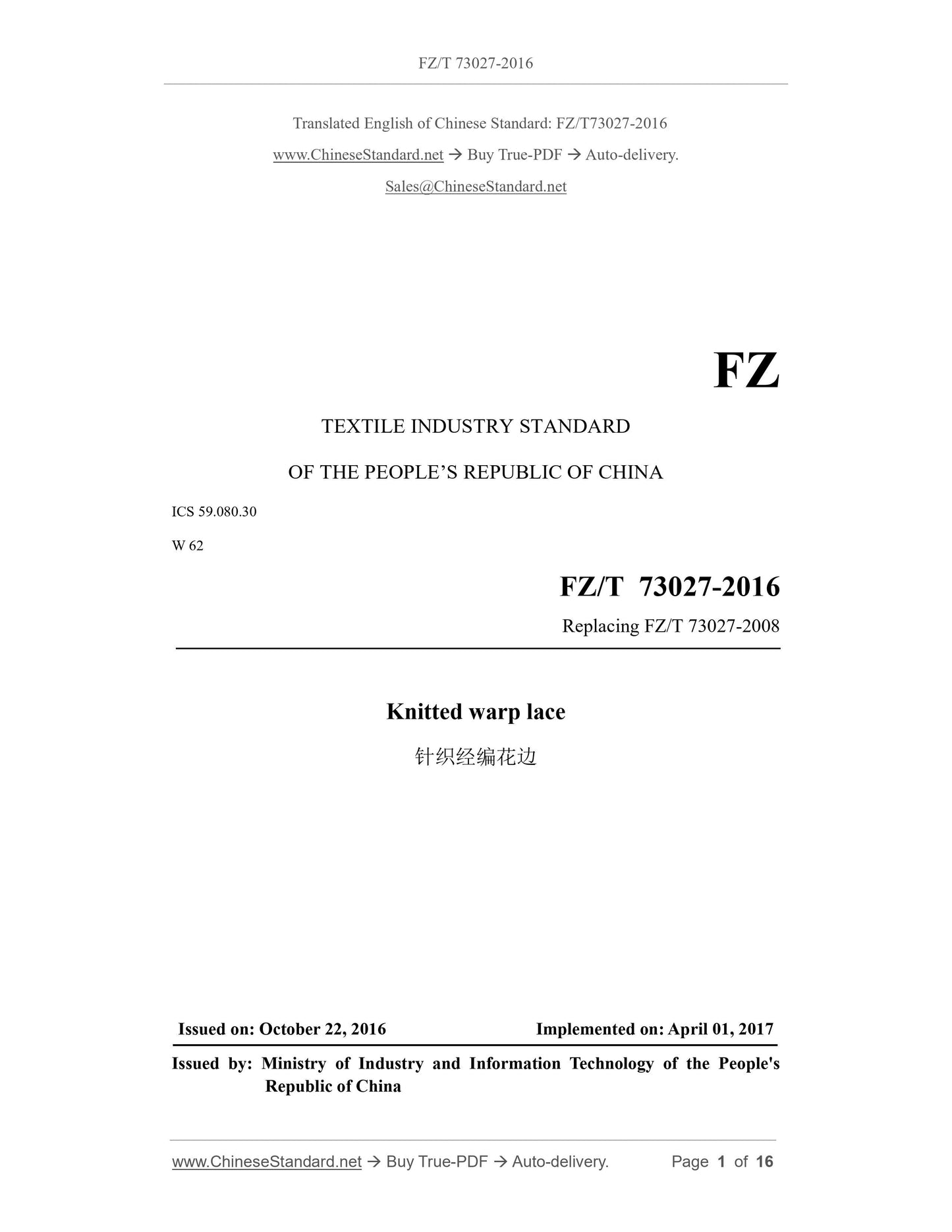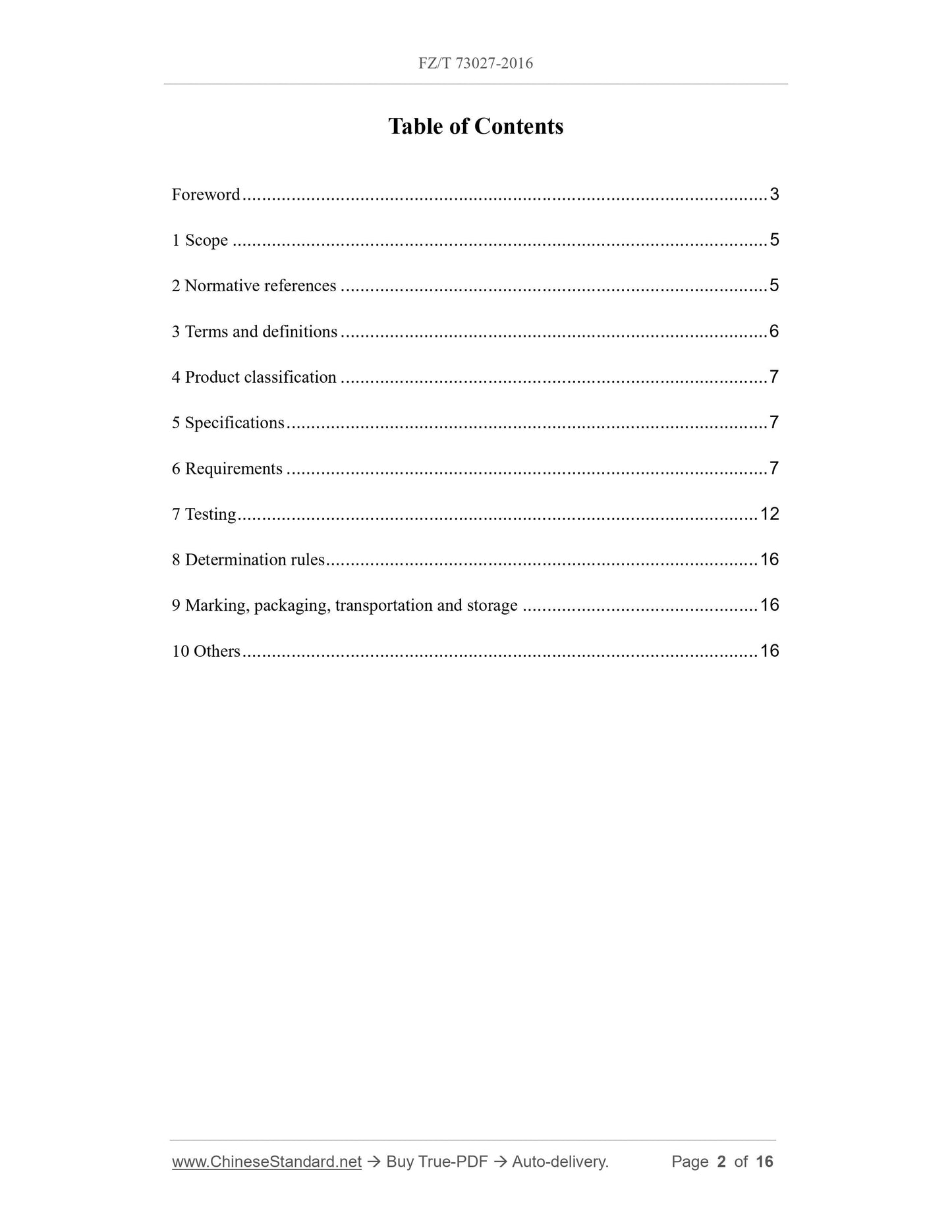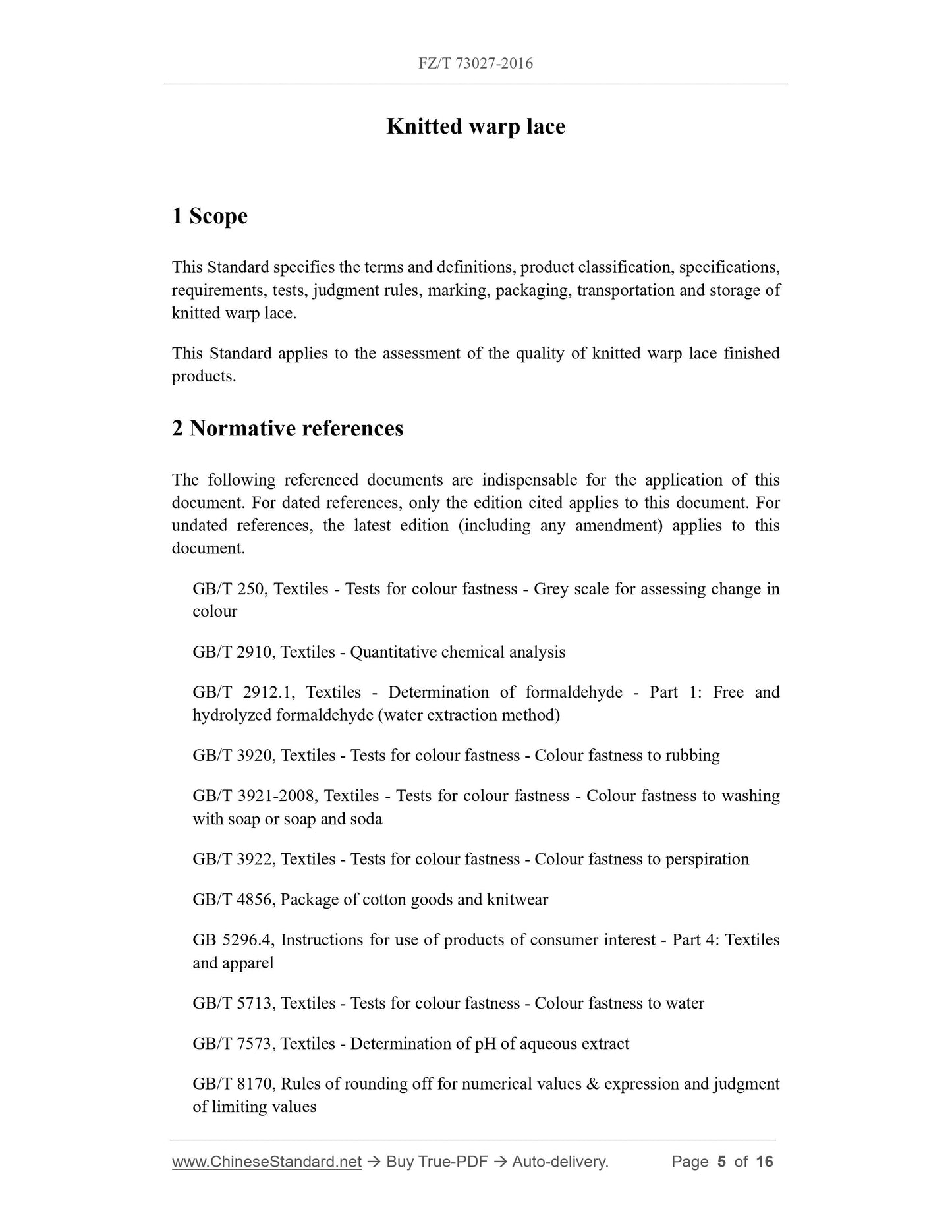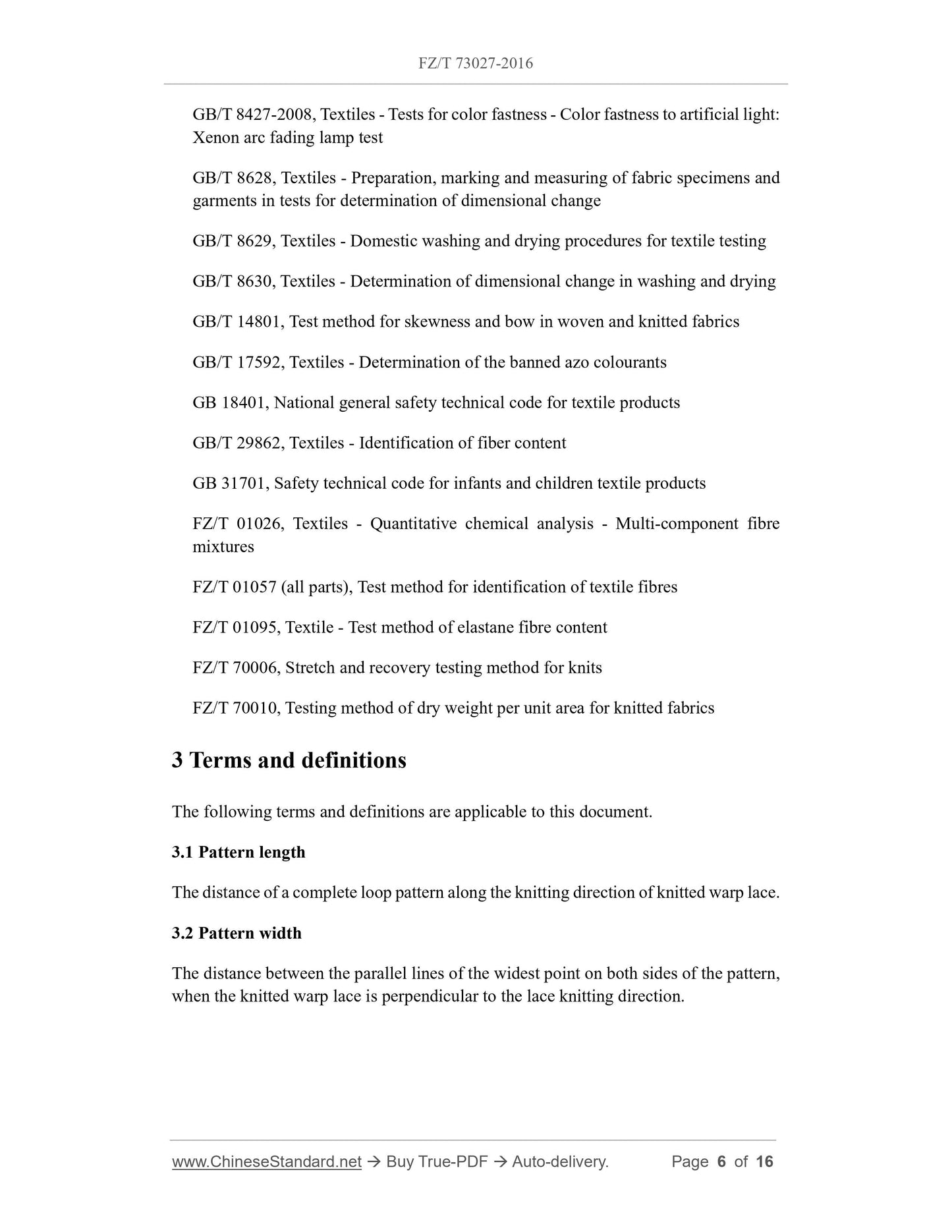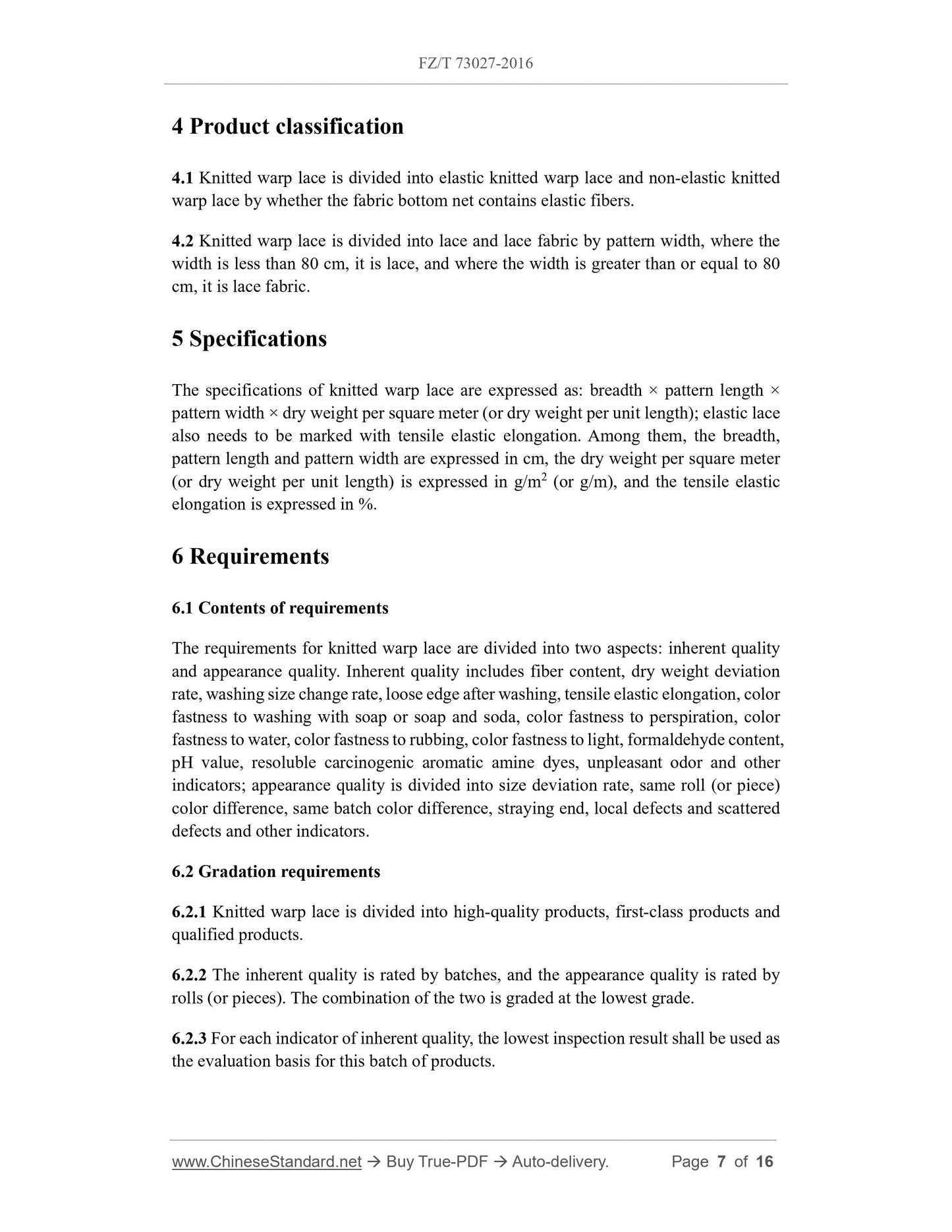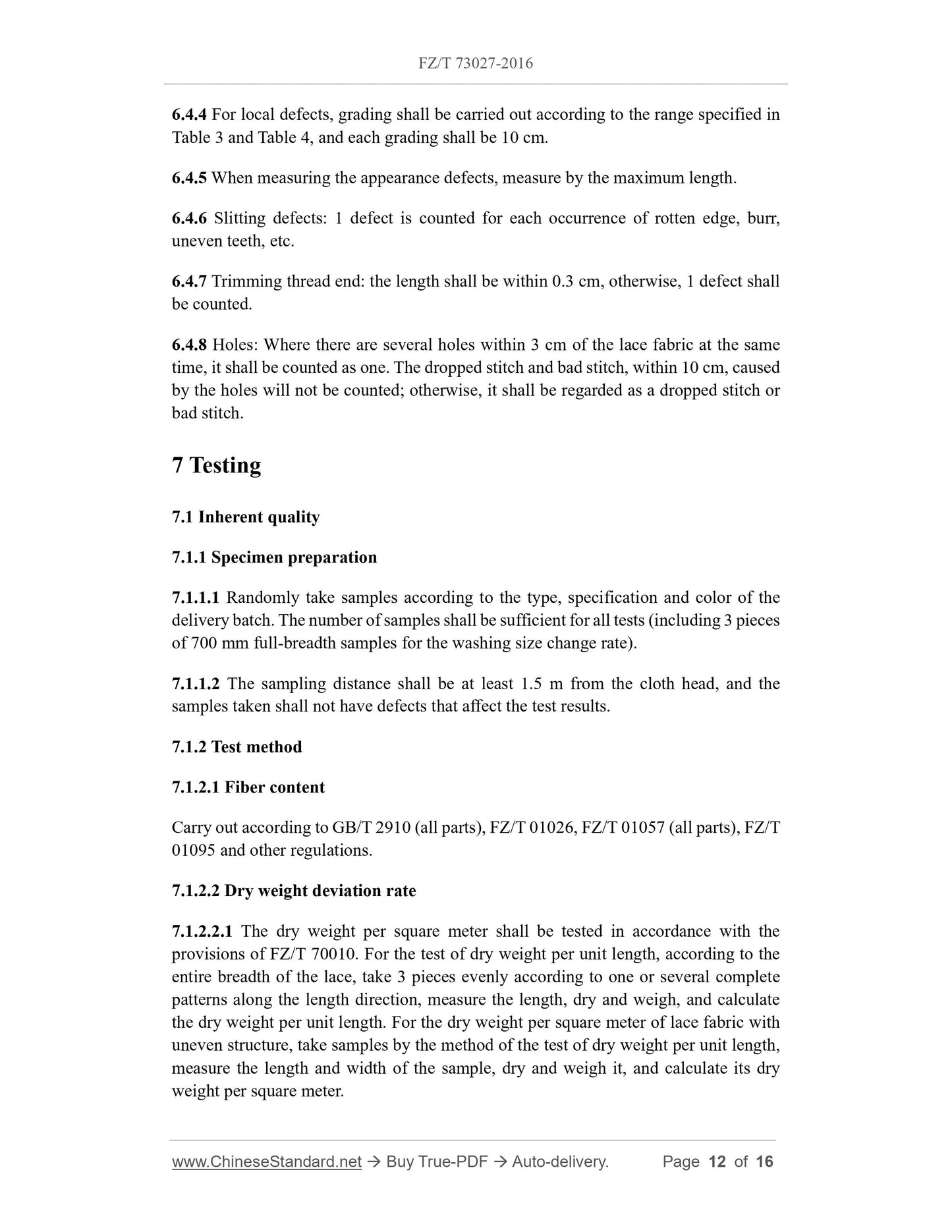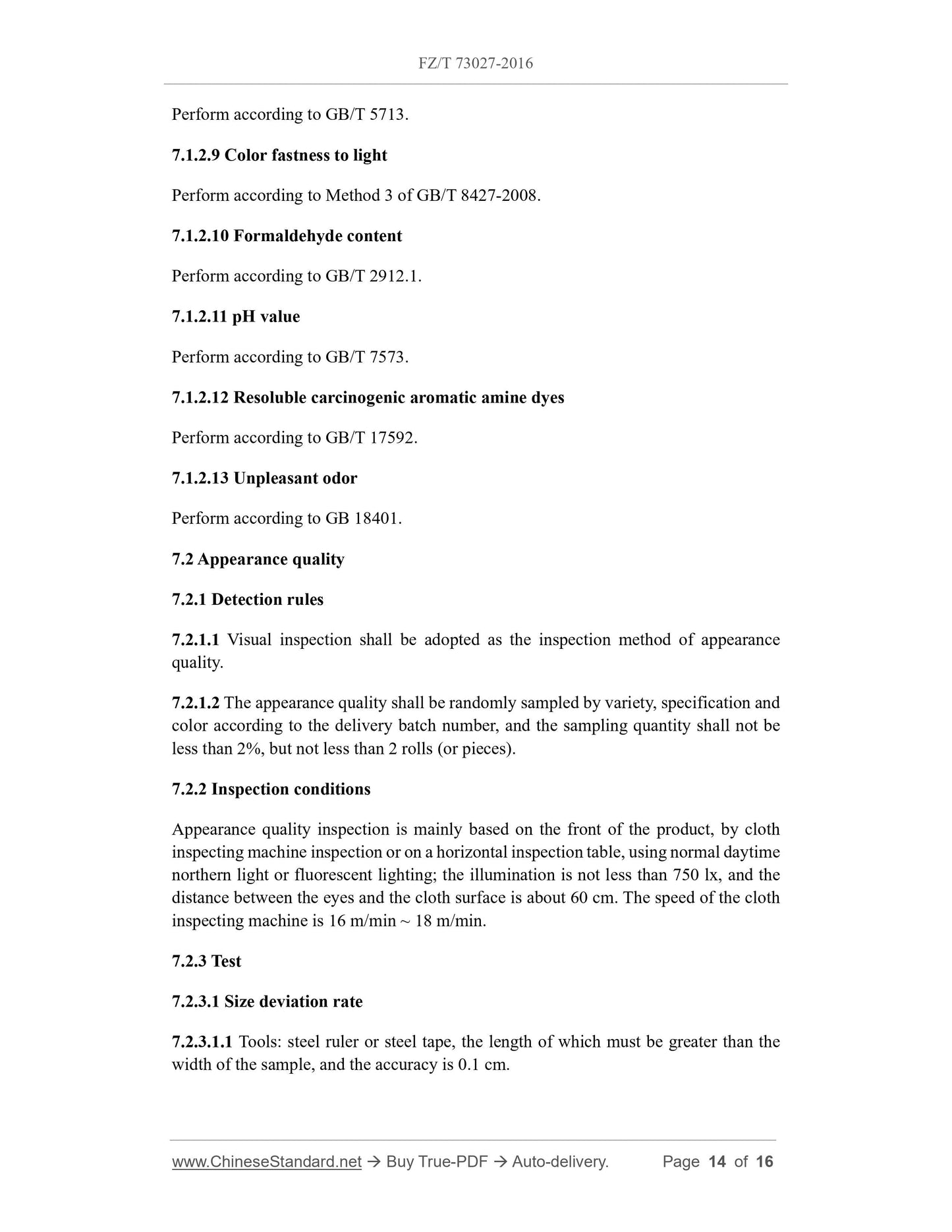1
/
su
7
PayPal, credit cards. Download editable-PDF and invoice in 1 second!
FZ/T 73027-2016 English PDF (FZT73027-2016)
FZ/T 73027-2016 English PDF (FZT73027-2016)
Prezzo di listino
$170.00 USD
Prezzo di listino
Prezzo scontato
$170.00 USD
Prezzo unitario
/
per
Spese di spedizione calcolate al check-out.
Impossibile caricare la disponibilità di ritiro
Delivery: 3 seconds. Download true-PDF + Invoice.
Get QUOTATION in 1-minute: Click FZ/T 73027-2016
Historical versions: FZ/T 73027-2016
Preview True-PDF (Reload/Scroll if blank)
FZ/T 73027-2016: Knitted warp lace
FZ/T 73027-2016
FZ
TEXTILE INDUSTRY STANDARD
ICS 59.080.30
W 62
Replacing FZ/T 73027-2008
Knitted warp lace
针织经编花边
ISSUED ON. OCTOBER 22, 2016
IMPLEMENTED ON. APRIL 01, 2017
Issued by. Ministry of Industry and Information Technology of the People's
Republic of China
Table of Contents
Foreword... 3
1 Scope... 5
2 Normative references... 5
3 Terms and definitions... 6
4 Product classification... 7
5 Specifications... 7
6 Requirements... 7
7 Testing... 12
8 Determination rules... 16
9 Marking, packaging, transportation and storage... 16
10 Others... 16
Knitted warp lace
1 Scope
This Standard specifies the terms and definitions, product classification, specifications,
requirements, tests, judgment rules, marking, packaging, transportation and storage of
knitted warp lace.
This Standard applies to the assessment of the quality of knitted warp lace finished
products.
2 Normative references
The following referenced documents are indispensable for the application of this
document. For dated references, only the edition cited applies to this document. For
undated references, the latest edition (including any amendment) applies to this
document.
GB/T 250, Textiles - Tests for colour fastness - Grey scale for assessing change in
colour
GB/T 2910, Textiles - Quantitative chemical analysis
GB/T 2912.1, Textiles - Determination of formaldehyde - Part 1.Free and
hydrolyzed formaldehyde (water extraction method)
GB/T 3920, Textiles - Tests for colour fastness - Colour fastness to rubbing
GB/T 3921-2008, Textiles - Tests for colour fastness - Colour fastness to washing
with soap or soap and soda
GB/T 3922, Textiles - Tests for colour fastness - Colour fastness to perspiration
GB/T 4856, Package of cotton goods and knitwear
GB 5296.4, Instructions for use of products of consumer interest - Part 4.Textiles
and apparel
GB/T 5713, Textiles - Tests for colour fastness - Colour fastness to water
GB/T 7573, Textiles - Determination of pH of aqueous extract
GB/T 8170, Rules of rounding off for numerical values and expression and judgment
of limiting values
GB/T 8427-2008, Textiles - Tests for color fastness - Color fastness to artificial light.
Xenon arc fading lamp test
GB/T 8628, Textiles - Preparation, marking and measuring of fabric specimens and
garments in tests for determination of dimensional change
GB/T 8629, Textiles - Domestic washing and drying procedures for textile testing
GB/T 8630, Textiles - Determination of dimensional change in washing and drying
GB/T 14801, Test method for skewness and bow in woven and knitted fabrics
GB/T 17592, Textiles - Determination of the banned azo colourants
GB 18401, National general safety technical code for textile products
GB/T 29862, Textiles - Identification of fiber content
GB 31701, Safety technical code for infants and children textile products
FZ/T 01026, Textiles - Quantitative chemical analysis - Multi-component fibre
mixtures
FZ/T 01057 (all parts), Test method for identification of textile fibres
FZ/T 01095, Textile - Test method of elastane fibre content
FZ/T 70006, Stretch and recovery testing method for knits
FZ/T 70010, Testing method of dry weight per unit area for knitted fabrics
3 Terms and definitions
The following terms and definitions are applicable to this document.
3.1 Pattern length
The distance of a complete loop pattern along the knitting direction of knitted warp lace.
3.2 Pattern width
The distance between the parallel lines of the widest point on both sides of the pattern,
when the knitted warp lace is perpendicular to the lace knitting direction.
4 Product classification
4.1 Knitted warp lace is divided into elastic knitted warp lace and non-elastic knitted
warp lace by whether the fabric bottom net contains elastic fibers.
4.2 Knitted warp lace is divided into lace and lace fabric by pattern width, where the
width is less than 80 cm, it is lace, and where the width is greater than or equal to 80
cm, it is lace fabric.
5 Specifications
The specifications of knitted warp lace are expressed as. breadth × pattern length ×
pattern width × dry weight per square meter (or dry weight per unit length); elastic lace
also needs to be marked with tensile elastic elongation. Among them, the breadth,
pattern length and pattern width are expressed in cm, the dry weight per square meter
(or dry weight per unit length) is expressed in g/m2 (or g/m), and the tensile elastic
elongation is expressed in %.
6 Requirements
6.1 Contents of requirements
The requirements for knitted warp lace are divided into two aspects. inherent quality
and appearance quality. Inherent quality includes fiber content, dry weight deviation
rate, washing size change rate, loose edge after washing, tensile elastic elongation, color
fastness to washing with soap or soap and soda, color fastness to perspiration, color
fastness to water, color fastness to rubbing, color fastness to light, formaldehyde content,
pH value, resoluble carcinogenic aromatic amine dyes, unpleasant odor and other
indicators; appearance quality is divided into size deviation rate, same roll (or piece)
color difference, same batch color difference, straying end, local defects and scattered
defects and other indicators.
6.2 Gradation requirements
6.2.1 Knitted warp lace is divided into high-quality products, first-class products and
qualified products.
6.2.2 The inherent quality is rated by batches, and the appearance quality is rated by
rolls (or pieces). The combination of the two is graded at the lowest grade.
6.2.3 For each indicator of inherent quality, the lowest inspection result shall be used as
the evaluation basis for this batch of products.
6.4.4 For local defects, grading shall be carried out according to the range specified in
Table 3 and Table 4, and each grading shall be 10 cm.
6.4.5 When measuring the appearance defects, measure by the maximum length.
6.4.6 Slitting defects. 1 defect is counted for each occurrence of rotten edge, burr,
uneven teeth, etc.
6.4.7 Trimming thread end. the length shall be within 0.3 cm, otherwise, 1 defect shall
be counted.
6.4.8 Holes. Where there are several holes within 3 cm of the lace fabric at the same
time, it shall be counted as one. The dropped stitch and bad stitch, within 10 cm, caused
by the holes will not be counted; otherwise, it shall be regarded as a dropped stitch or
bad stitch.
7 Testing
7.1 Inherent quality
7.1.1 Specimen preparation
7.1.1.1 Randomly take samples according to the type, specification and color of the
delivery batch. The number of samples shall be sufficient for all tests (including 3 pieces
of 700 mm full-breadth samples for the washing size change rate).
7.1.1.2 The sampling distance shall be at least 1.5 m from the cloth head, and the
samples taken shall not have defects that affect the test results.
7.1.2 Test method
7.1.2.1 Fiber content
Carry out according to GB/T 2910 (all parts), FZ/T 01026, FZ/T 01057 (all parts), FZ/T
01095 and other regulations.
7.1.2.2 Dry weight deviation rate
7.1.2.2.1 The dry weight per square meter shall be tested in accordance with the
provisions of FZ/T 70010.For the test of dry weight per unit length, according to the
entire breadth of the lace, take 3 pieces evenly according to one or several complete
patterns along the length direction, measure the length, dry and weigh, and calculate
Get QUOTATION in 1-minute: Click FZ/T 73027-2016
Historical versions: FZ/T 73027-2016
Preview True-PDF (Reload/Scroll if blank)
FZ/T 73027-2016: Knitted warp lace
FZ/T 73027-2016
FZ
TEXTILE INDUSTRY STANDARD
ICS 59.080.30
W 62
Replacing FZ/T 73027-2008
Knitted warp lace
针织经编花边
ISSUED ON. OCTOBER 22, 2016
IMPLEMENTED ON. APRIL 01, 2017
Issued by. Ministry of Industry and Information Technology of the People's
Republic of China
Table of Contents
Foreword... 3
1 Scope... 5
2 Normative references... 5
3 Terms and definitions... 6
4 Product classification... 7
5 Specifications... 7
6 Requirements... 7
7 Testing... 12
8 Determination rules... 16
9 Marking, packaging, transportation and storage... 16
10 Others... 16
Knitted warp lace
1 Scope
This Standard specifies the terms and definitions, product classification, specifications,
requirements, tests, judgment rules, marking, packaging, transportation and storage of
knitted warp lace.
This Standard applies to the assessment of the quality of knitted warp lace finished
products.
2 Normative references
The following referenced documents are indispensable for the application of this
document. For dated references, only the edition cited applies to this document. For
undated references, the latest edition (including any amendment) applies to this
document.
GB/T 250, Textiles - Tests for colour fastness - Grey scale for assessing change in
colour
GB/T 2910, Textiles - Quantitative chemical analysis
GB/T 2912.1, Textiles - Determination of formaldehyde - Part 1.Free and
hydrolyzed formaldehyde (water extraction method)
GB/T 3920, Textiles - Tests for colour fastness - Colour fastness to rubbing
GB/T 3921-2008, Textiles - Tests for colour fastness - Colour fastness to washing
with soap or soap and soda
GB/T 3922, Textiles - Tests for colour fastness - Colour fastness to perspiration
GB/T 4856, Package of cotton goods and knitwear
GB 5296.4, Instructions for use of products of consumer interest - Part 4.Textiles
and apparel
GB/T 5713, Textiles - Tests for colour fastness - Colour fastness to water
GB/T 7573, Textiles - Determination of pH of aqueous extract
GB/T 8170, Rules of rounding off for numerical values and expression and judgment
of limiting values
GB/T 8427-2008, Textiles - Tests for color fastness - Color fastness to artificial light.
Xenon arc fading lamp test
GB/T 8628, Textiles - Preparation, marking and measuring of fabric specimens and
garments in tests for determination of dimensional change
GB/T 8629, Textiles - Domestic washing and drying procedures for textile testing
GB/T 8630, Textiles - Determination of dimensional change in washing and drying
GB/T 14801, Test method for skewness and bow in woven and knitted fabrics
GB/T 17592, Textiles - Determination of the banned azo colourants
GB 18401, National general safety technical code for textile products
GB/T 29862, Textiles - Identification of fiber content
GB 31701, Safety technical code for infants and children textile products
FZ/T 01026, Textiles - Quantitative chemical analysis - Multi-component fibre
mixtures
FZ/T 01057 (all parts), Test method for identification of textile fibres
FZ/T 01095, Textile - Test method of elastane fibre content
FZ/T 70006, Stretch and recovery testing method for knits
FZ/T 70010, Testing method of dry weight per unit area for knitted fabrics
3 Terms and definitions
The following terms and definitions are applicable to this document.
3.1 Pattern length
The distance of a complete loop pattern along the knitting direction of knitted warp lace.
3.2 Pattern width
The distance between the parallel lines of the widest point on both sides of the pattern,
when the knitted warp lace is perpendicular to the lace knitting direction.
4 Product classification
4.1 Knitted warp lace is divided into elastic knitted warp lace and non-elastic knitted
warp lace by whether the fabric bottom net contains elastic fibers.
4.2 Knitted warp lace is divided into lace and lace fabric by pattern width, where the
width is less than 80 cm, it is lace, and where the width is greater than or equal to 80
cm, it is lace fabric.
5 Specifications
The specifications of knitted warp lace are expressed as. breadth × pattern length ×
pattern width × dry weight per square meter (or dry weight per unit length); elastic lace
also needs to be marked with tensile elastic elongation. Among them, the breadth,
pattern length and pattern width are expressed in cm, the dry weight per square meter
(or dry weight per unit length) is expressed in g/m2 (or g/m), and the tensile elastic
elongation is expressed in %.
6 Requirements
6.1 Contents of requirements
The requirements for knitted warp lace are divided into two aspects. inherent quality
and appearance quality. Inherent quality includes fiber content, dry weight deviation
rate, washing size change rate, loose edge after washing, tensile elastic elongation, color
fastness to washing with soap or soap and soda, color fastness to perspiration, color
fastness to water, color fastness to rubbing, color fastness to light, formaldehyde content,
pH value, resoluble carcinogenic aromatic amine dyes, unpleasant odor and other
indicators; appearance quality is divided into size deviation rate, same roll (or piece)
color difference, same batch color difference, straying end, local defects and scattered
defects and other indicators.
6.2 Gradation requirements
6.2.1 Knitted warp lace is divided into high-quality products, first-class products and
qualified products.
6.2.2 The inherent quality is rated by batches, and the appearance quality is rated by
rolls (or pieces). The combination of the two is graded at the lowest grade.
6.2.3 For each indicator of inherent quality, the lowest inspection result shall be used as
the evaluation basis for this batch of products.
6.4.4 For local defects, grading shall be carried out according to the range specified in
Table 3 and Table 4, and each grading shall be 10 cm.
6.4.5 When measuring the appearance defects, measure by the maximum length.
6.4.6 Slitting defects. 1 defect is counted for each occurrence of rotten edge, burr,
uneven teeth, etc.
6.4.7 Trimming thread end. the length shall be within 0.3 cm, otherwise, 1 defect shall
be counted.
6.4.8 Holes. Where there are several holes within 3 cm of the lace fabric at the same
time, it shall be counted as one. The dropped stitch and bad stitch, within 10 cm, caused
by the holes will not be counted; otherwise, it shall be regarded as a dropped stitch or
bad stitch.
7 Testing
7.1 Inherent quality
7.1.1 Specimen preparation
7.1.1.1 Randomly take samples according to the type, specification and color of the
delivery batch. The number of samples shall be sufficient for all tests (including 3 pieces
of 700 mm full-breadth samples for the washing size change rate).
7.1.1.2 The sampling distance shall be at least 1.5 m from the cloth head, and the
samples taken shall not have defects that affect the test results.
7.1.2 Test method
7.1.2.1 Fiber content
Carry out according to GB/T 2910 (all parts), FZ/T 01026, FZ/T 01057 (all parts), FZ/T
01095 and other regulations.
7.1.2.2 Dry weight deviation rate
7.1.2.2.1 The dry weight per square meter shall be tested in accordance with the
provisions of FZ/T 70010.For the test of dry weight per unit length, according to the
entire breadth of the lace, take 3 pieces evenly according to one or several complete
patterns along the length direction, measure the length, dry and weigh, and calculate
Share
